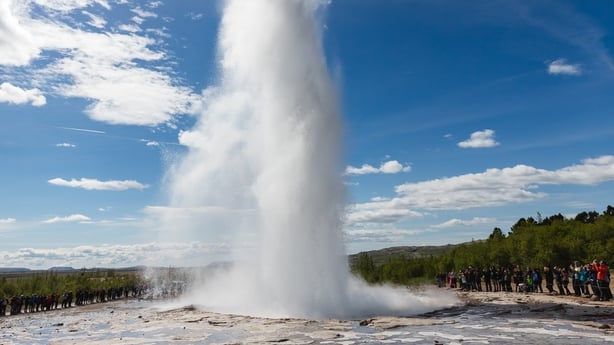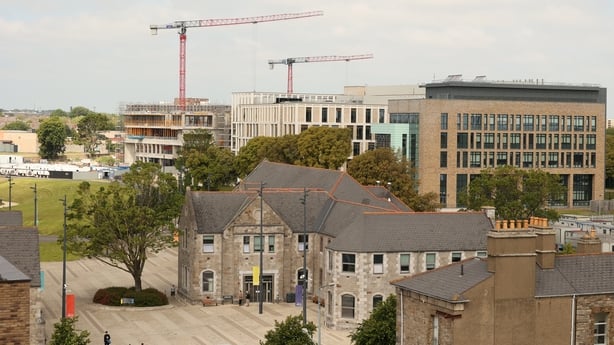Greenhouse gas emissions at Technological University (TU) Dublin in Grangegorman could be halved by drilling boreholes into the ground on the campus and harvesting the geothermal energy that has now been confirmed to be available there.
Geothermal energy is the heat in the rocks and water beneath the surface of solid earth. For the first 500m down, it is mostly stored heat from the sun.
But go any deeper, and it is scalding heat from the core of the earth that starts to be felt and the deeper down you go, the hotter it gets.
In places located near tectonic fault lines that are close to the surface - such as New Zealand, Iceland, or far-eastern Russia - the geothermal power of the earth's core is plain to see in the many hot water geysers and steam that gush forth.
Hot lava flows from active volcanos tell the same tale.
It is hot down there. In fact, geologists estimate that the temperature at the core of the earth is the same as the surface of the sun.

But there was nothing on the surface, in the grounds of TU Dublin’s Grangegorman campus to indicate that far beneath one’s feet lies the greatest possible source of reliable, safe, renewable, local, decarbonised heat.
Nothing until now, that is.
Earlier this year, TU Dublin teamed up with Geological Survey Ireland to drill a borehole 1km deep just to measure how hot it was at that depth. What they found has thrilled the experts involved and spurred them on to want to drill further.
In general for Ireland, it is estimated that the temperature of the rocks below ground level increases by an average of 21°C for every km of depth.
Dr Siobhán Power of Geological Survey Ireland had expected a bit higher than that from the Grangegorman borehole.
Due of her knowledge of the ancient and deep limestone structure beneath Dublin, along with the impact of expected faults lines in the area, she was hoping for 30°C of heat for every kilometre they went down. But what they found was even hotter than that.
The temperature in the borehole was 38.5°C at 1km below the ground.
Dr Power says that is a really good result, especially for Dublin, and it suggests it is very worthwhile drilling even further to see how much heat might be available to tap into.
Emissions targets
Like all public sector bodies, TU Dublin faces the enormous challenge of having to cut its greenhouse gas emissions in half by 2030.
Mark Geraghty, Environment and Sustainability Manager at TU Dublin, said the college considered the traditional renewable energy sources including wind and solar power. But it was quickly concluded that neither wind nor solar would work for them.
One of the unique things about the Grangegorman campus is that, historically, it has its own district heating system. This means none of the many buildings on the site have an independent central heating system.
Instead, they are all connected to a central source that pools the energy and pumps heated water through pipes into all the buildings on the campus. These days, Grangegorman’s district heating is powered by a very modern and highly efficient gas-powered setup.
But even with that efficiency, the gas the college uses for heating accounts for half of all the greenhouse gas emissions on campus.
The search is on for an alternative way to fuel the district heating system, with the smallest possible environmental footprint and the smallest impact on the existing system.
Find a way to fully decarbonise the heating system, and in one fell swoop, the target of a 50% cut in greenhouse gas emissions across the entire university is achievable.
This is a very big incentive.

The college deemed it to be a good enough reason to team up with Geological Survey Ireland and go testing to see just how hot it is likely to be deep under the ground.
"We found 38.5C, which was beyond what the science was suggesting and that has led us to want to drill 2.5km deep, the first borehole of that depth on the island of Ireland," Mr Geraghty said.
"If we drill down and find water, that would be the holy grail because we could simply pump the water up to heat and run our own systems and manage to decarbonise our heating completely.
"If we don't find water, we could still use a closed system whereby a liquid would be put down through our boreholes to gather the heat at a depth of 2km and that liquid would then come back up to heat our boilers. It is the perfect indigenous kind of renewable energy we are looking for on this Island."
Geological Survey Ireland’s Dr Power is just as enthusiastic as Mr Geraghty about the possibilities.
"It is heat that is there that we just haven’t used yet in Ireland. It has great potential to decarbonise our heat sector, starting with our public buildings, universities, and hospitals, before moving on to housing developments," she said.
"One third of our full budget for energy in Ireland goes on heat. But we are still working on 99% fossil fuel heating. That needs to change."
There is a catch, however. It is all about cost.
Read more: £3m to explore geothermal power potential in N Ireland
Climate change requires urgent response - President
Ireland will not meet upcoming carbon budget targets, climate council warns
Sure enough, once the drilling and engineering works involved in harvesting geothermal heat are completed, the energy to be tapped will be forever free. But the costs and investments required to achieve that are all upfront, and they are very expensive.
TU Dublin says it would need about €14m to install the geothermal energy harvesting system that would free them forever from fossil fuels.
This a huge upfront cost compared to the installation of a modern gas heating system say, although the payoff would be far greater in the long term.
Justifying that kind of investment would require Government decisionmakers to start thinking very long term about what they would get for their money. That might call for a very different mindset among decision makers at the Department of Finance and elsewhere in Government.
"Geothermal energy.. we have ignored it for too long."
There is no guarantee that will happen anytime soon, but that is not all.
Geological Survey Ireland wants another €4m to €6m to do a deep and thorough geological seismic survey of the rock structure beneath the entire Dublin area.
This is required so people can understand where the best prospects are located, where to find the fault lines carrying hot underground water so they can be safely tapped into, and so much more.
Minister for the Environment Eamon Ryan says he is very excited by the project at TU Dublin and the prospects for a local secure, decarbonised, and long-term source of renewable energy for Dublin and elsewhere.
"Geothermal is an energy we know is there. We have ignored it for too long," the minister said.
"We haven’t paid enough attention to how we provide heat. We must stop burning fossil fuels and a whole variety of other alternatives will come into view. Geothermal is a very attractive alternative.
"Once you build the original drillhole and put in the pumping equipment to get the hot water, it will run for 60 years. It doesn’t stop," Mr Ryan added.
"It is a resource that you keep pumping around in a circular motion and that means it will be there for ever and a day. So, I am really encouraged by this. It makes a lot of sense."







